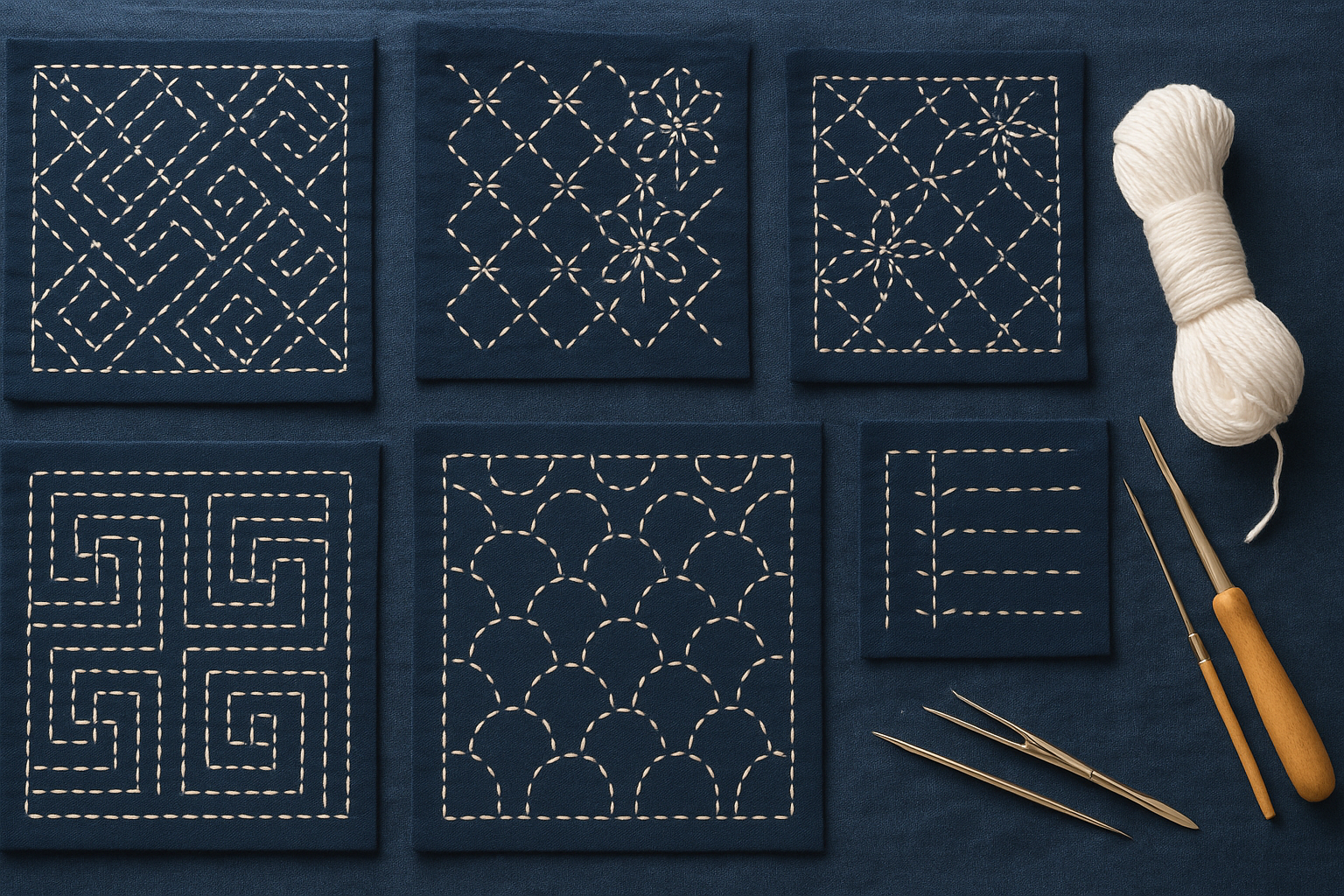Sashiko patterns are more than just decorative stitches; they represent a centuries-old Japanese tradition that blends practicality with artistry. The word sashiko means “little stabs,” referring to the simple running stitches that form its signature geometric designs. At first glance, sashiko patterns may seem like beautiful motifs stitched on indigo cloth, but they carry a much deeper story rooted in Japanese culture, sustainability, and craftsmanship.
Historically, these designs were developed as a method of reinforcing clothing, making fabric stronger and longer lasting. Over time, sashiko evolved into a form of cultural expression, where each stitch and motif carried meaning. Patterns such as waves, hemp leaves, or tortoise shells were not just chosen for their visual appeal but also for the symbolic wishes they represented—protection, prosperity, resilience, and harmony.
Today, sashiko patterns continue to inspire artists, designers, and textile enthusiasts worldwide. They are used in modern quilting, fashion design, and even sustainable lifestyle practices, proving that traditions can be both timeless and adaptable. Understanding sashiko is not just about embroidery; it is about appreciating the connection between human creativity, cultural heritage, and mindful living.
The Origins of Sashiko Patterns
The story of sashiko begins in rural Japan during the Edo period (1603–1868). In a society where fabric was precious and often scarce, households had to find ways to preserve their clothing for as long as possible. Cotton was not widely available to common people, so garments made from hemp or linen were frequently patched, layered, and reinforced.
Sashiko emerged as a solution: a simple running stitch repeated in patterns that held layers of fabric together while also creating beautiful designs. Indigo-dyed cloth became a popular base for this stitching, and white cotton thread offered a striking contrast, making the designs stand out.
For Japanese farmers and fishermen, clothing stitched with sashiko patterns symbolized both resilience and resourcefulness. These garments were practical, offering warmth, strength, and longevity. Yet at the same time, they reflected a quiet elegance—ordinary people turned necessity into art.
Over time, sashiko shifted from being purely functional to also being decorative. Families passed down techniques through generations, and local regions developed their own preferred motifs, each influenced by local culture and natural surroundings. What started as a humble form of mending slowly became recognized as a significant part of Japanese textile heritage.
Symbolism Behind Traditional Sashiko Designs
One of the most fascinating aspects of sashiko patterns is their symbolic meaning. Unlike random decoration, each motif carries an intentional message, often linked to nature, spirituality, or cultural beliefs.
The Seigaiha, or “blue ocean waves,” is among the most iconic sashiko patterns. Its rhythmic curves symbolize peace, resilience, and the endless strength of the sea. Fishermen and coastal families favored this design, as it represented safety and good fortune in their daily lives.
Another widely used motif is the Asanoha, or “hemp leaf.” This geometric design resembles the pointed leaves of the hemp plant, which grows rapidly and vigorously. The hemp leaf pattern was believed to symbolize growth, vitality, and protection, making it a common choice for children’s clothing.
The Kikkō, or “tortoise shell,” is another traditional design with deep meaning. In Japanese culture, tortoises are associated with longevity and stability. The hexagonal shapes of the Kikkō pattern symbolize endurance, making it a favorite for garments meant to last through generations.
The Shippo, or “seven treasures,” consists of overlapping circles that create a harmonious, interlocking pattern. This design represents unity, harmony, and endless connection, symbolizing how individual parts come together to form a greater whole.
These motifs reveal that sashiko patterns were never only about beauty. They served as protective symbols, carrying wishes for health, safety, and prosperity. Wearing a garment stitched with these patterns was akin to carrying blessings stitched into the very fabric of daily life.
Techniques That Define Sashiko Patterns
At the heart of sashiko lies the running stitch, repeated in careful rhythms to create geometric designs. Although the technique seems simple, the artistry lies in precision and consistency. Stitches must be evenly spaced, creating harmony across the fabric.
Traditional sashiko used indigo-dyed cloth as the foundation, not just for aesthetic reasons but also for practical ones. Indigo dye naturally repelled insects and was durable, making it an ideal choice for work garments. The bright white thread stood out clearly against this dark background, emphasizing the patterns.
Tools for sashiko remain humble: a long needle, strong cotton thread, and fabric. Yet within these limits, artisans created an endless variety of patterns. Some designs are linear and structured, like grids or diamonds, while others mimic natural forms such as waves or leaves.
Another defining feature of sashiko is the way patterns are repeated. Unlike random stitches, sashiko designs are carefully planned so the geometric rhythm remains consistent across the cloth. This repetition creates a meditative effect, both for the maker and the viewer.
Over the years, variations of sashiko developed. Some styles focused on reinforcing fabric through dense stitching, while others emphasized decorative motifs. Regardless of the approach, the essence remained the same: combining strength and beauty in a single thread.
Sashiko Patterns in Modern Design
While sashiko has ancient roots, it continues to influence modern design in surprising ways. Today, artists, crafters, and designers around the world are rediscovering the value of this traditional technique and reimagining it for contemporary life.
In the world of fashion, sashiko patterns appear in denim repair, jackets, and accessories. The rise of visible mending—a movement that embraces repairing clothing as a form of creativity rather than hiding wear—has brought sashiko into global focus. Jeans with sashiko-stitched patches, for example, transform damaged fabric into a unique, personalized work of art.
Quilting and home décor also feature sashiko patterns. The repetition of geometric motifs brings a sense of calm and order, making them popular in table runners, pillow covers, and wall hangings. By blending tradition with modern materials, these pieces connect everyday living with centuries-old artistry.
Sustainability movements have further elevated sashiko’s role in modern life. As people become more conscious about reducing waste and valuing handmade work, sashiko offers an eco-friendly solution that is both functional and aesthetic. Instead of discarding worn fabric, sashiko patterns give new life to old textiles, making them not only usable but beautiful.
For many designers, sashiko is more than just stitching—it is a philosophy of mindfulness, patience, and respect for resources. This philosophy resonates strongly with modern audiences seeking meaningful, sustainable lifestyles.
Why Sashiko Patterns Remain Timeless?
The timelessness of sashiko patterns lies in their ability to blend tradition with relevance. At their core, these designs represent resilience, creativity, and cultural storytelling. Yet they also adapt seamlessly to modern needs, from sustainable fashion to global art movements.
Sashiko’s strength is its balance between simplicity and depth. The stitches are basic, yet when arranged into repeating motifs, they create a visual richness that feels both ancient and contemporary. This accessibility has allowed sashiko to cross cultural and geographical boundaries, inspiring people worldwide to pick up needle and thread.
Moreover, sashiko patterns embody values that remain relevant today: sustainability, mindfulness, and connection. In a world often driven by fast consumption, sashiko reminds us of the beauty in slowing down, repairing rather than discarding, and finding meaning in small details.
Their endurance also speaks to the universal human need for both function and beauty. What began as a practical method of reinforcing fabric has become a global symbol of cultural heritage and artistic expression. From Japanese villages to modern design studios, sashiko continues to tell stories through stitches.
Conclusion
Sashiko patterns represent a remarkable blend of history, culture, and creativity. Rooted in necessity, they grew into an art form that carried deep symbolism, offering protection, blessings, and beauty stitched into everyday life. Each motif—waves, hemp leaves, tortoise shells, or circles—reminds us of the timeless connection between human hands, nature, and meaning.
In modern times, sashiko patterns have found new life in quilting, sustainable fashion, and interior design. They inspire people not only for their aesthetic appeal but also for the values they carry: resilience, harmony, and respect for resources.
The enduring appeal of sashiko lies in its simplicity and depth. A humble stitch, repeated with care, becomes something greater—a bridge between past and present, function and beauty, tradition and innovation. For anyone who appreciates meaningful design, sashiko patterns remain an endless source of inspiration, proof that the smallest stitches can create lasting impact.
My name is Mustafa, and I have been blogging for over 5 years. I am passionate about sharing complete, accurate, and helpful information with my readers. Along with managing content on The Matcha Read, I also contribute blog posts to premium websites. My goal is to provide valuable insights in a clear and easy-to-understand way, so every reader walks away with useful knowledge.










